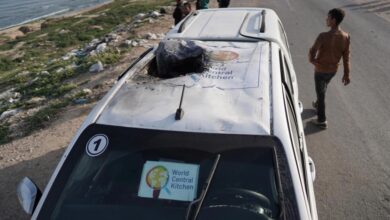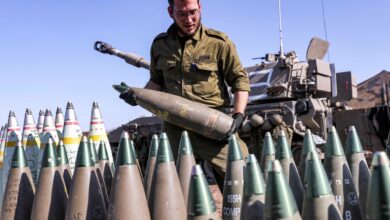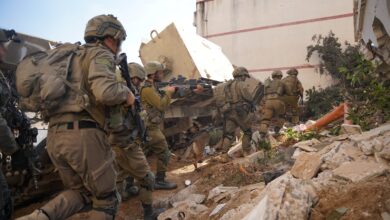
As a former Special Operations Forces Combat Controller, I’ve been a part of, and have seen, the revolution of Battlefield Air Operations.
The use of tactical unmanned aircraft systems (UAS), for example, has evolved dramatically since their first deployment on the battlefield nearly 20 years ago – from single mission tools to highly sophisticated, multi-mission capable aircraft that now provide actionable intelligence and the persistent situational awareness needed in today’s dynamic operating environments.
Rapidly deployable via hand or bungee launch, with flexible payload options and rated for all-environment operation, Group 1 UAS, such as AeroVironment’s Puma all environment system, provide land or maritime operators with actionable intelligence, surveillance and reconnaissance (ISR) in day, night, and low light conditions in even the harshest of environments.
When combined with man-portable tactical missile systems, such as AeroVironment’s Switchblade, these aerial assets provide platoons with advanced sensor-to-shooter capabilities, increasing force projection and soldier lethality for engaging beyond-line-of-sight enemy targets.
Unmanned Aircraft Systems and Mission Success
Today, forces operating without organic tactical UAS assets can become pinned-down by enemy fire for a lengthy period. They must radio for manned attack aircraft or Group 3 or 4 UAS to provide Close Air Support or risk sending additional troops directly into the line of fire.
In many cases, these larger aerial assets may not be available in time to make a difference for the forces under fire due to distance, scarcity, or enemy air defense systems.
However, with small tactical UAS and tactical missile systems packed in their rucksacks, troops can immediately secure persistent eyes-in-the-sky intel that can directly impact mission success and mean the difference between life and death.
Using my first-hand experience, let’s take a look at two potential operation scenarios that might occur in an Area of Responsibility (AOR) such as Africa: one focused on a mission with only a tactical UAS, and another that combines the technology of a tactical UAS and a tactical missile system, providing the platoon with the immediate precision munitions advantage it needs, straight from a rucksack.
Mission With Only Tactical UAS
In the first scenario, a combined force of US Marines comprising elements from the 2nd Marine Division, 6th Marine Regiment, and USSOCOM MARSOC are conducting offensive and stability operations from Camp Simba, near Manda Bay, Kenya, due to the increased threat posed by al-Shabaab.
This robust tenant force has secured the local area and coordinates jointly with Kenyan military partners to ensure clear lines of communication, guaranteeing a secure environment for US and allied forces to conduct cross border reconnaissance and expeditionary operations into neighboring countries.
Fifty miles to the northeast of Camp Simba, a platoon of Marines has established a forward Mission Support Site (MSS) to conduct border surveillance operations. Postured just outside Ras Kamboni, a small town on Somalia’s coast, the platoon is equipped with two AeroVironment Puma 3 AE and one Puma LE (long endurance) UAS, along with their common ground control stations (GCS), air vehicle batteries and chargers, Mantis i45 EO/IR gimbaled sensors, and a spare parts kit.
The Puma LE, which flies for 5.5 hours before needing a quick battery swap-out and has a range of 60 km when used with AeroVironment’s Long-Range Tracking Antenna, was received by the unit only days before deployment. Because of the qualified Line Replaceable Unit (LRU) component interoperability, standard training, and parts commonality with Puma 3 AE (2.5 hours endurance), the regiment was confident there would be no issue integrating the Puma LE into their operations, and operate both Puma systems concurrently.

Bringing both systems into the field provides the field commander with the option to take multiple Puma systems downrange, select the appropriate aircraft based on the type of flight operation to be performed, and then simply swap-in needed LRU components to execute the mission successfully.
Launching from the Marine’s MSS, its UAS flight operators conduct 24-hour surveillance using Puma LE across miles of the border and several Named Areas of Interest (NAI) that include border crossing points, known enemy staging areas, and likely routes of ingress.
In addition to the Mantis i45 EO/IR sensor suite, the platoon was provided with a developmental signals intelligence (SIGINT) sensor designed to fit into the secondary payload bay of the Puma LE, and connected via its built-in power supply and Ethernet interface.
As the UAS operator collects high resolution, full-motion aerial intel of the border, mission operators monitor the aircraft location in real-time via its AES-256 encrypted digital link, utilizing advanced mapping software and conducting signals analysis in the direction of Somalia.
Due to its proximity onboard the Puma LE, the SIGINT package intercepts short-range, low power handset communications, which can then be translated with a combination of speech recognition algorithms and interpreters.

With the ability to control the aircraft’s sensor payloads independently, the Puma LE operator is immediately able to slew the i45 sensor to the discovered coordinates to verify the radio emitter locations and establish intent.
Late in the evening, while conducting Puma LE ISR & SIGINT flight operations, mission operators intercept a flurry of handset activity and identify massing of military age males well within the Somali border.
Marines at the MSS base are raised to full alert status while a ground assault quick reaction force (QRF) departs Camp Simba in the event of a cross border attack on the MSS. As the Puma LE UAS team continues visual and SIGINT surveillance, they observe several multi-vehicle convoys departing staging areas and heading toward the Kenyan border.
Due to the continuous coverage provided by Puma LE, US forces ascertain an attack is imminent, establishing the enemy’s intent. With the QRF linked-up to secure the MSS, the Puma LE operator continues to monitor convoy progress, which had stopped short of the border due to the arrival of additional US forces.
On link-up, the Joint Terminal Attack Controller (JTAC) attached to the QRF utilizes coordinates derived from the Puma LE to nominate the convoys as enemy targets. As a result, US commanders scramble nearby fighter aircraft and approve them to strike validated enemy targets with no harm done to the civilian populace.
Mission Combining Tactical UAS Technology and Tactical Missile System
In the second scenario, the following day, two squads of MARSOC operators are patrolling the border in the vicinity of Kolbio, a small town 100 miles north of Camp Simba, in non-standard commercial vehicles to reduce their signature.
Tasked with conducting area familiarization and sensor emplacement, the team has man-portable crew-served weapons, but limited mounted heavy weapons.
Equipped with a single Puma LE and GCS, plus four AeroVironment Switchblade tactical missile systems, the team leader elects to keep the Puma LE airborne while in transit, providing real-time route surveillance and overwatch.
As they travel parallel to the border, the Puma LE operator observes numerous all-terrain troop transport vehicles on a course to intercept the US convoy.
The team leader advises the operations center that a troops-in-contact situation is imminent, and selects a defensible fighting position as one of the enemy convoys attempts to flank the American vehicles.
With the Puma LE orbiting above the US position, the team leader has complete situational awareness as enemy fighters dismount and move to make contact. Enemy fighters attack from two quadrants, trading small arms and RPG fire, and although the enemy has superior numbers, the Marines hold the line.

With no Close Air Support available and heliborne QRF at least 30 minutes away, the team begins to receive accurate mortar fire that disables two of the four American vehicles and injures several personnel.
The team leader directs the Puma LE operator to locate the mortar, and orders the Switchblade operator to prep its ground tube-launch system. By using the Puma LE Mantis i45 electro-optical (EO) sensor center field of view coordinates, the operator identifies and locates the mortar approximately 1,500 meters northeast of their position.
The Switchblade operator then launches the tactical missile system and instantly transfers target coordinates via machine-to-machine, sensor-to-shooter communication, eliminating the potential for data entry error. After its launch, the Switchblade autonomously navigates to the designated mortar position.
As the Switchblade tactical missile closes on the target, the team leader visually compares full-motion video from both assets to ensure 100 percent positive identification of the target and then views Puma LE video to perform the resulting battle damage assessment.
With the mortar and crew successfully eliminated, remaining enemy personnel retreat, allowing US forces to treat wounded personnel, and fortify defensive positions against potential future incursions.
As described, these scenarios showcase the actionable intelligence, force protection, and increased soldier lethality that advanced UAS and teamed UAS/tactical missile systems can provide across today’s complex battlefronts.
Man-portable, rapidly deployable, interoperable, and with multi-mission capabilities, these battle-proven UAS provide ground commanders with the option of selecting the appropriate aircraft based on the type of mission when time is of the essence and in the most rugged environments.
This increased capability provides immediate ISR and overmatches force protection responsiveness to front line tactical units and security personnel.










